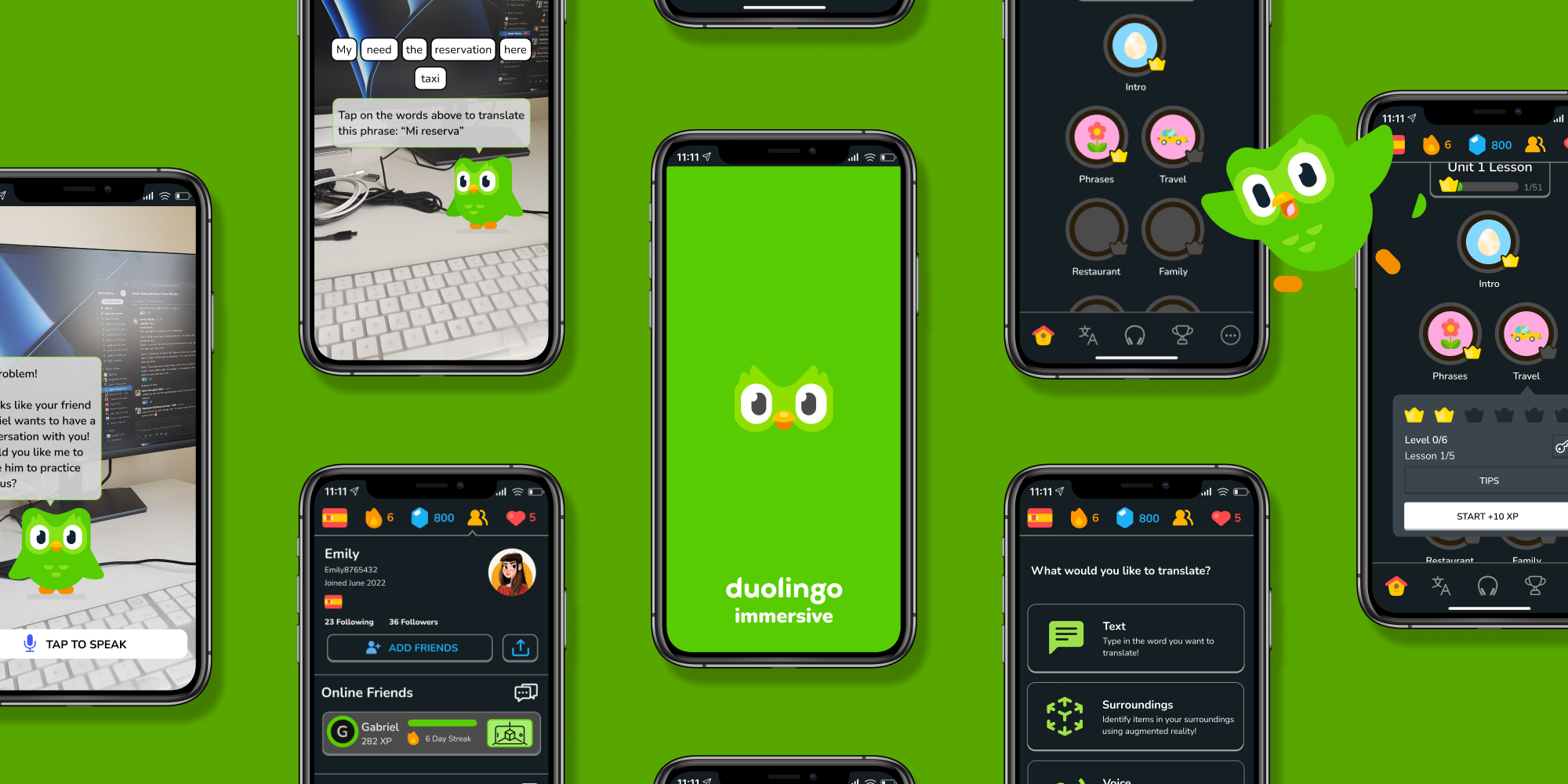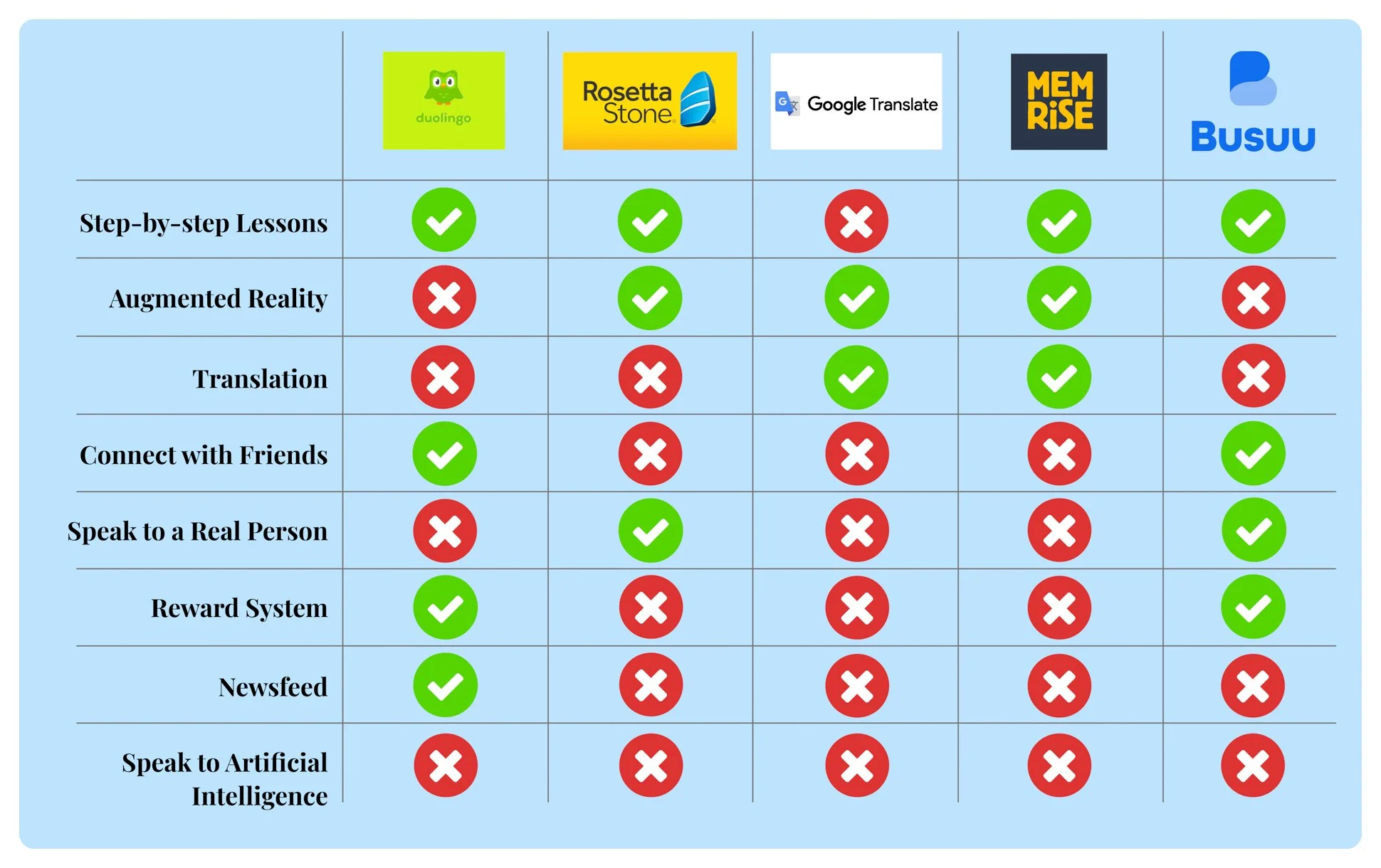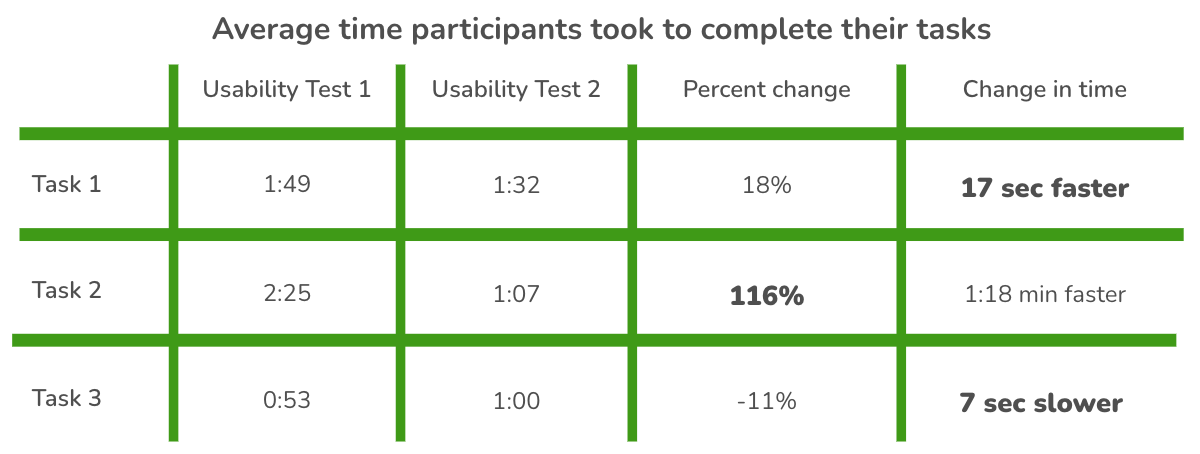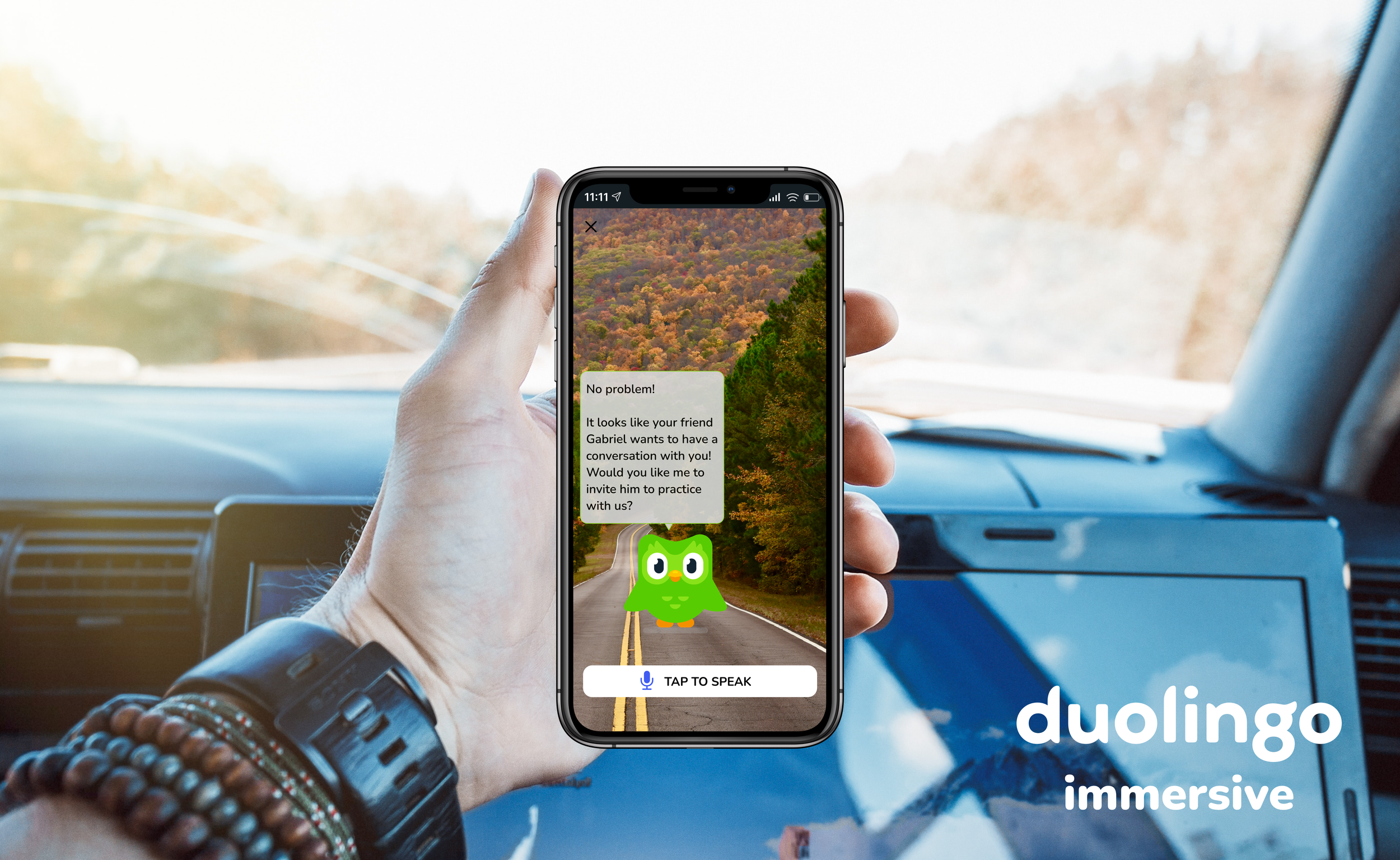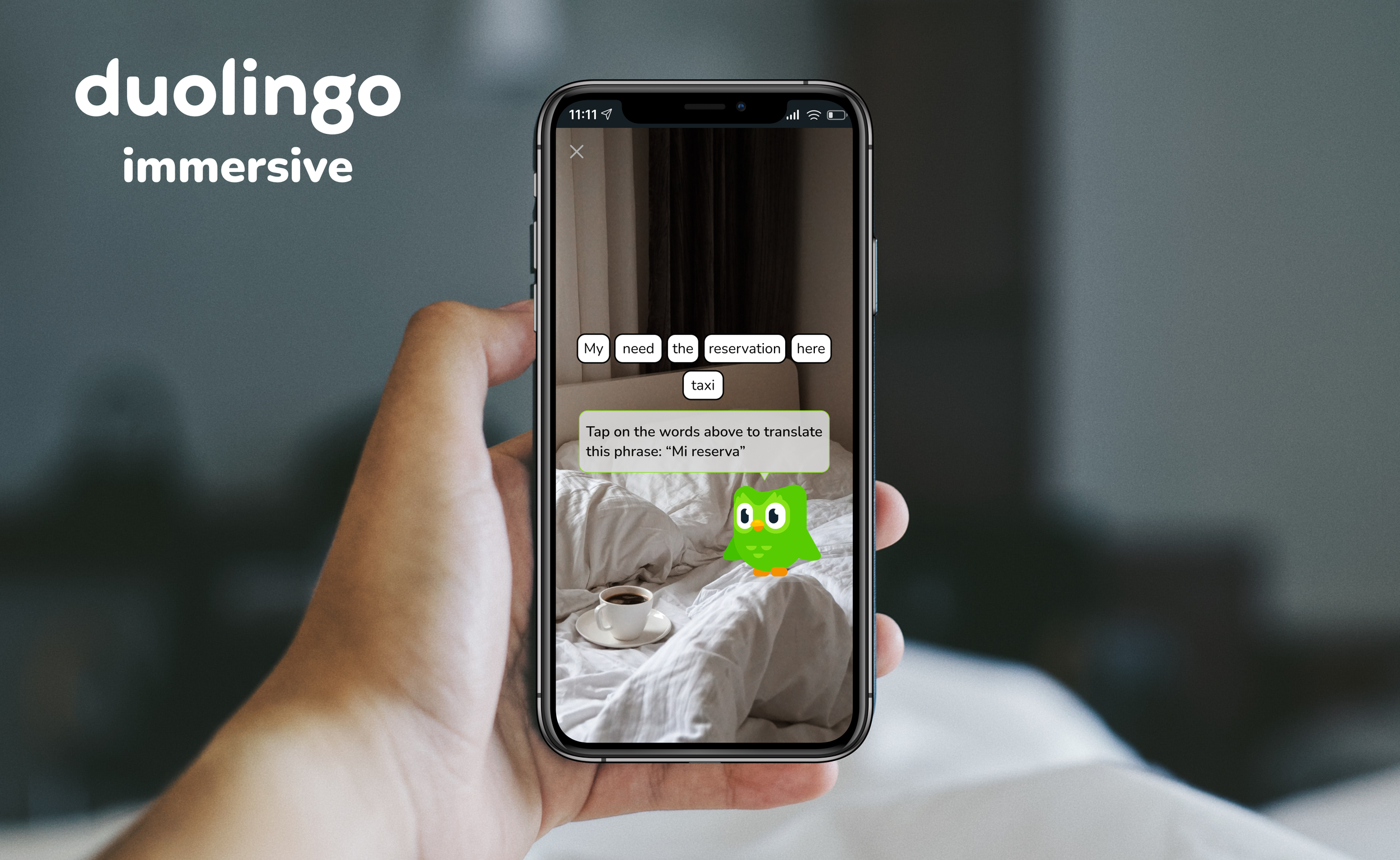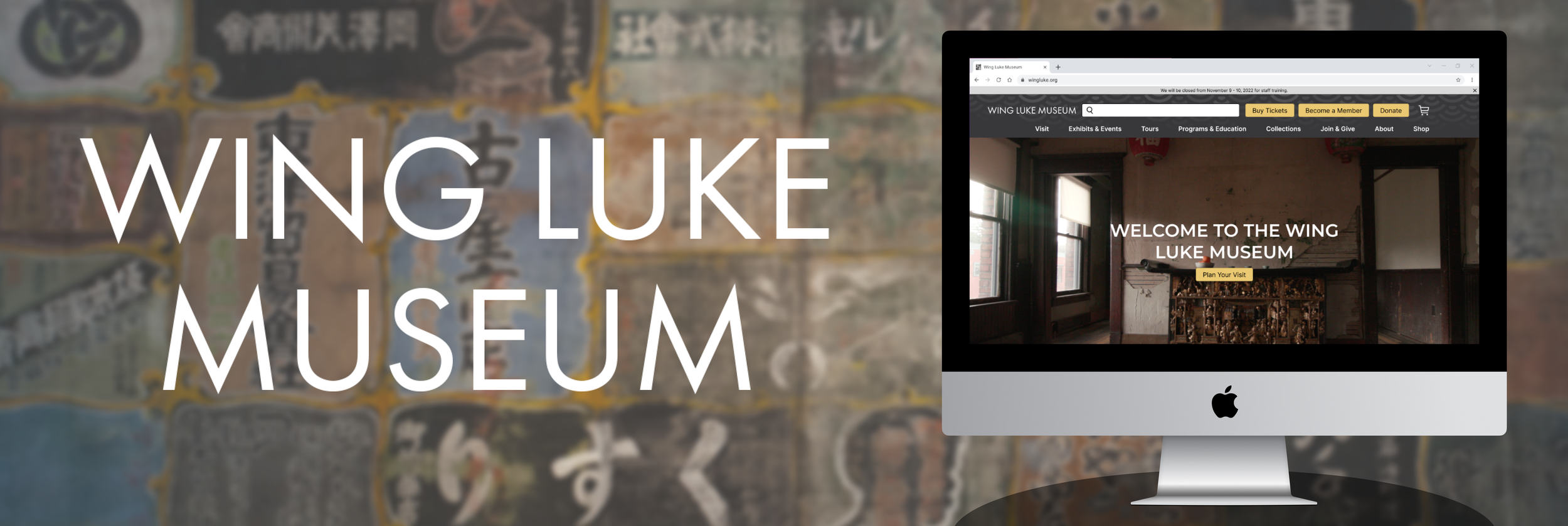Duolingo Immersive
Duolingo Immersive
ROLE
UX/UI Designer, Researcher
PROJECT
Duolingo (conceptual)
TIMELINE
June 2022 (2 week sprint)
TEAM
UX Designer - Stephanie Malilong
UX Designer - Teresa Witzke
TOOLS
Pen & Paper, Figma, Adobe Illustrator, Adobe Aero, Adobe Premiere Pro, Adobe Photoshop, Slack, Zoom, Microsoft Teams
METHODS
Survey, Competitive Analysis, Comparative Analysis, User Interviews, Affinity Mapping, User Persona, User Flow, Sketches, Sitemap, Grayscale Wireframe, High Fidelity Wireframe, Usability Testing
OVERVIEW
The Duolingo language learning app is a widely popular platform, with over 200 million users worldwide, offering online courses in over 30 languages. Our team aimed to enhance the current language experiences offered by Duolingo by leveraging the power of community and collaboration, connecting users to practice language skills together, incorporating emerging technologies like Augmented Reality (AR) and Virtual Reality (VR) and encouraging human-to-human communication in the target language to create a more engaging, immersive and effective language learning experience for users.
MY ROLE
As the UX/UI designer and researcher, my role in this project was to leverage the community to enhance the current language experiences Duolingo offers by connecting users to practice language skills together. I contributed to the project by conducting research, including conducting user interviews, creating user personas, and designing and testing new features for the app that focus on community and collaboration. Specifically, I also contributed in the design and integration of the Augmented Reality (AR) aspect of the project, which allows the users to have an immersive and interactive language learning experience. Overall, my role and contributions helped to improve the overall language learning experience for users by incorporating community and collaboration features and immersive AR experiences into the app.
Everyone can Duolingo.
Working together to make language learning fun, free, and effective for anyone who wants to learn, wherever they are.
Research
Competitive Analysis
Snapchat
Ability to have your bitmoji do actions in an AR setting.
Easy to add AR once you know how to implement it by pressing your finger on the screen or hitting the emoji icon to your right,
Apollo’s Moon Shot
AR experiences allow you to explore different aspects of the Apollo missions
Both the menu and the navigation bar open up sections without leaving the home screen.
‘Allows for anonymity by providing a way for users to connect with others via an avatar’
I wanted to perform a comparative analysis on apps that featured augmented reality. There were 2 that stood out - Snapchat and The Smithsonian Channel’s, Apollo’s Moon Shot . With Snapchat users are able to place their bitmojis into spaces using AR. This allows for anonymity by providing a way for users to connect with others via an avatar. With Apollo’s Moon Shot’s app navigation, categories are clear and concise and users are able to open up sections w/o leaving the home screen. This allows for simple and straightforward navigation while still orienting users to where they are in the app.
Competitive Analysis - Feature Inventory
I made a feature inventory, to get a better understanding of what each app offers:
3 out of 4 competitors have an augmented reality (AR) feature.
2 of the 4 competitors incorporate a translation feature.
Rosetta Stone is one of the closest competitor. One of their features is speaking to a real person.
User Interviews
I wanted to build upon the education goals of continuously making the products more effective, more fun, more engaging, and more social. To better understand what these goals mean to people learning a second language, we conducted 6 user interviews with individuals who have learned or are currently learning a second language.
Research Goals
We wanted to know:
How do users learn best?
How do they gauge progress when learning another language?
What are their needs around creating a safe, digital, learning environment?
How do they connect with others that have similar interests?
What interfaces to they use to communicate with peers?
How can mutual cooperation between users facilitate faster learning?
Interview Insights
Make learning more customizable since people use a variety of tools to learn & have different learning styles.
Regular practice with others is important for retaining knowledge & being held accountable.
People like to be connected, but want to be safe when they connect with others.
Users want a sensory immersive learning experience and be immersed in the culture that they are learning.
Define
Identifying and Prioritizing Pain Points
How might we provide a way for our users to safely connect with other people so she can practice regularly with native speakers and other people at her skill level?
How might we provide a customizable experience so our users can tailor her language studies to her preferred learning style and learn at her own pace?
How might we take advantage of emerging technologies to provide immersive learning and cultural experiences that enhances and does not detract from her studies?
Defining the Problem
We wanted to evolve the application to utilize new tools in order to bring a more fun and immersive experience for our users. From our research findings, users wanted the experience to be more immersive to really embrace the language. And opportunities for more speech practice with native speakers.
Design
Design Studio - Starting Those First Sketches
A design studio is a type of UX workshop that combines divergent and convergent thinking. This allowed the 3 of us to converge and share our ideas into 1 vision.
Design Studio - Bringing Our Ideas Together
This was the beginning of Duolingo Immersive, making language learning more fun and immersing the users into the language lessons in a new way.
Lesson: Introduction
We all have to start somewhere, as I added new features, they started to evolve and take shape.
Usability Test Goals and Insights
To ensure that our design was in line with what users want, we performed usability tests with 6 participants to observe how they interacted with the app.
Task 1: Find a friend online to chat with in augmented reality.
The goal was for users to be able to complete this task in less than 3 minutes with no more than 1 error
On average, it took participants 1:49 to complete this task, and most participants had no errors
Task 2: Complete a lesson in augmented reality.
The goal was for users to be able to complete this task in less than 4 minutes with no more than 1 error
Participants were able to complete the task in an average time of 2:25, but everyone had more than 1 error
Task 3: Translate an object in augmented reality.
The goal was for users to be able to complete this task in less than 3 minutes with no more than 1 error
Participants were able to complete the task in an average time of 0:53, everyone had more than 1 error
Graduating To The Next Phase
From the usability test findings, we implemented some changes to make the application more intuitive to use.
Another Usability Test & Insights
I conducted a second round of usability tests with 3 participants. Each participant was given the same 3 tasks from our first round of usability testing
Task 1: Find a friend online to chat with in augmented reality.
Task 2: Find a lesson and complete it in augmented reality.
Task 3: Translate your surroundings in augmented reality.
The Final Prototype
Next Steps
Expand the Augmented Reality (AR) features by adding the following elements:
Allowing users to connect with Duolingo-verified native speakers for more immersive and authentic conversational practice.
Incorporating live captions, so users can have real-time translations during their conversations with native speakers or other users in a different language.
Adding the ability to translate text by using the device camera, allowing users to easily translate signs, menus, or other written materials they encounter in their daily lives.
Integration of a Virtual Reality (VR) component to Duolingo:
Create an immersive learning experience in virtual reality where users can learn the language in its native country.
Allow users to immerse themselves in a virtual environment that mimics the culture and setting of the language they are learning.
Takeaways
From working on this Duolingo redesign project, I have gained a deeper understanding of the challenges and opportunities that come with creating a successful language learning app. I learned that Duolingo is a great product that has a clear mission to make language learning fun and accessible for everyone. However, one of the biggest challenges is to get users to continue learning after the initial excitement of starting a new course wears off.
The project also highlighted the importance of leveraging the community and incorporating emerging technologies like AR and VR to keep users engaged and motivated. Through my contributions to the project, I was able to propose new features such as AR-based conversation practice with native speakers, live captions, and translation using the device camera.
Overall, I believe that expanding the AR features and adding a VR option will create a more immersive and fun learning environment that will attract and retain users. The project reinforced the idea that making language learning fun and interactive is key to success and I am excited to continue exploring ways to make this happen.
Note: I do not work for, nor am I affiliated with, Duolingo. I did this UX case study as I am a UX designer who likes to solve problems and Duolingo is one of my favourite products.
Thanks for reading! If you want to collaborate, talk about UX Design, or want to say hello, find me at aaron.l.yeung@gmail.com or connect via LinkedIn.

